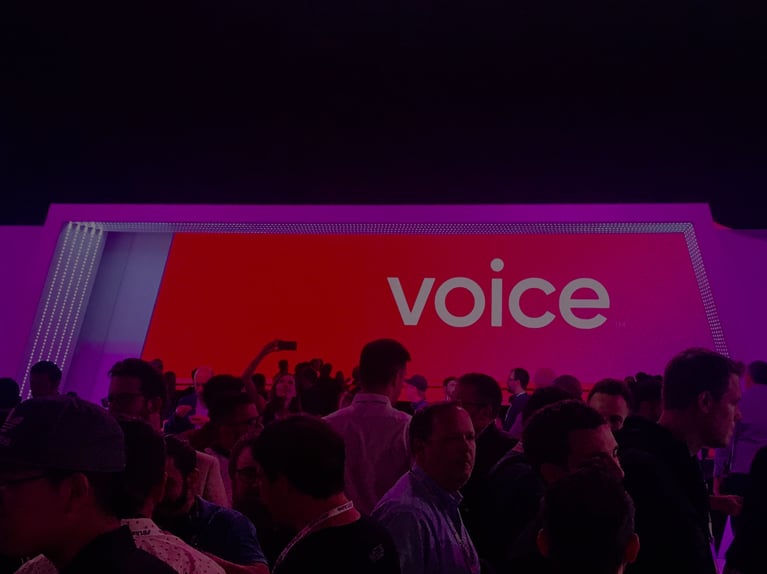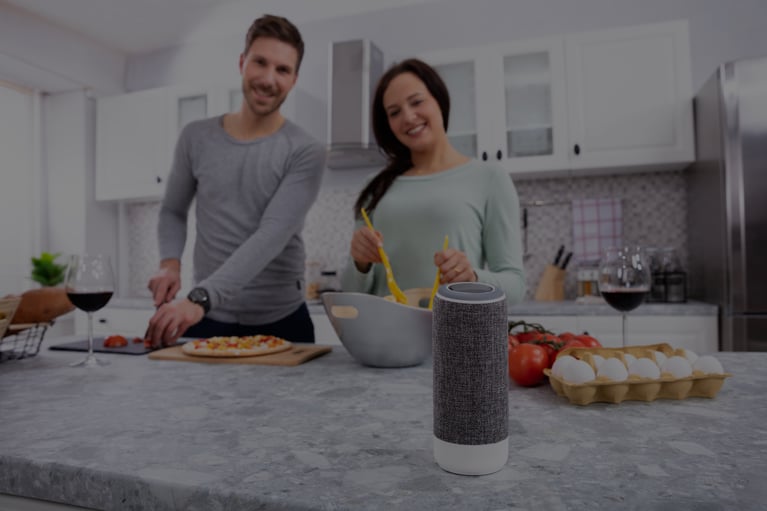Alex Farr
First web, then mobile, now voice.
This isn’t a gimmick.
.jpeg?width=2100&name=AdobeStock_294356618%20(1).jpeg)
Voice assistants are revolutionizing the way we engage with digital content and brands. And whilst the technology is still relatively new, it’s gained some serious momentum with consumers:
- There was 2.5 billion voice-enabled devices in use at the end of 2018
- One in three U.S. households has an Amazon Echo or Google Home
- 65% of people who own an Amazon Echo or Google Home can’t imagine going back to the days before they had a smart speaker
As with any new channel, you might need some help to get your head around it, and you’ll want plenty of reassurance that you’re absolutely right to be investing in a Voice App for your organization. So let us help you with that.
WHAT ARE VOICE ASSISTANTS?
.jpg?width=1920&name=voice-speakers%20(3).jpg)
Voice assistants are digital assistants that can carry out spoken commands. They’re powered by conversational AI; using voice recognition, speech synthesis, and natural language processing (NLP) to enable users to perform a variety of tasks through different Voice Apps.
Right now, there are six voice assistants in existence. You’re probably familiar with a couple of them: Google Assistant, Amazon’s Alexa, Microsoft’s Cortana, Apple’s Siri, Samsung’s Bixby, and Hound by SoundHound.
WHERE ARE THEY FOUND?
These assistants are most commonly found in our phones, computer devices, and smart speakers like the Amazon Echo, Google Home, Apple HomePod, and Samsung Galaxy Home.
A survey from PWC revealed the way in which people are accessing voice technology: smartphone 57%, laptop 29%, tablet 29%, desktop 29%, speaker 27%, TV remote 21%, car navigation 20%, and wearable 14%.
Voice is also increasingly being built into third-party devices – like Facebook’s Portal device and other speakers like Sonos – and connecting with other devices or gadgets to make them smarter; making life easier for people who use them.
MARKET SHARE

Usage across different voice assistants vary, whilst people frequently use more than one assistant i.e. someone may use an Amazon Echo at work, and then Google Home at home.
Market share is expected to change over time as newer arrivals to the voice economy build on their presence and release more devices.
Siri was launched as far back as 2011, but Alexa wasn’t launched until 2014, Cortana in 2015, Google Assistant and Hound in 2016, and Bixby in just 2017.
HOW ARE VOICE ASSISTANTS BEING USED?
Right now, people are still mostly using voice for simple commands: playing music, digesting the news, checking the weather, setting reminders, getting answers to questions, and so on. Voice assistants are also connecting to an increasing number of household gadgets to create smarter homes.
According to Google, 72% of people who own voice-activated speakers say that their devices are indeed used as part of their daily routines.
That’s because voice often enables us to get things done more quickly or easily, and it’s connecting more people with digital content than ever before – in a more natural way.
Speed
Let’s say you wanted to find out what time your General Practitioner closes. Consider how long it might take you to call the reception desk, or perform a web search to retrieve that information.
Well with voice – so long as the organization is on it – people can get that information immediately. Making it x10 quicker than any other channel.
Ease
Voice has minimal barrier to entry. It’s not like web or mobile apps where you have to know how to use them. Voice is powered by conversation – it doesn’t get much easier than that.
Plus, it allows people to multitask.
ACCESSIBILITY
Voice is hands-free and can be used without a screen. This makes it a serious game changer for people with dexterity problems or visual impairments; connecting ever-more people with digital content.
WHICH CONSUMERS ARE USING VOICE ASSISTANTS?
Because voice is so easy to use, it’s not just popular with the tech-savvy or younger generations.
According to PWC, though consumers aged 18-24 are adopting voice technology at a faster rate than their older counterparts, they are statistically more likely to use their voice assistants less. 25-49-year olds are using them most often and are more likely to be considered “heavy” users.
ARE BUSINESSES USING VOICE ASSISTANTS?
Increasingly so. Though there are more organizations who want to be on voice than are actually on it:
- 91% of business decision makers want to invest in voice today and 88% want to support multiple platforms
- 84% of business leaders see value in Voicebots, while only 2% have a productive Voice solution in place
- 78% of Enterprise IT leaders have conversational AI planned and 73% of these organizations are unable to take action, due to a lack of cross-platform solution
The problem is organizations just haven’t been able to afford the cost of hiring developers or agencies to create a Voice App.
But more organizations are beginning to make that investment, and one reason for that is they are securing their voice domains , which are limited and scarce.
BENEFITS TO ORGANIZATIONS
Voice is universally useful:
- Customers want omni-channel; voice helps organizations meet that expectation
- It’s not 9-5pm like most customer service teams; customers can engage on voice 24/7
- Voice acts as effective first line support; lessening the need for customers to contact customer service in the first place – and reducing the cost to serve them
Ultimately, any organization with a website or customer service team stands to benefit from voice.
WHAT'S NEXT FOR VOICE?
We’ve barely even scratched the surface with voice. Not only has conversational AI got some growing to do, but because most organizations have so far struggled to adopt it, it means voice is still ripe for innovation.
Like with any new channel, the organizations that are first to get on and innovate will be the ones to dominate on it for years to come.
And the next big thing will be transacting on voice, which people are already starting to do with the limited number of brands who currently facilitate such customer journeys.
The future beyond is even more exciting, but don’t get caught standing still looking at what’s ahead. You might think you have all the time in the world to get on voice, but there’s a limited number of voice domains. You’ll want one that’s aligned to your brand if you’re to succeed in the voice economy.












